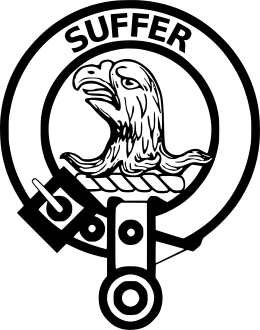Clan Haldane facts for kids
Quick facts for kids Clan Haldane |
|||
|---|---|---|---|

Crest: An eagle's head erased Or
|
|||
| Motto | Suffer | ||
| Chief | |||
 |
|||
| Martin Haldane | |||
| of Gleneagles | |||
| Seat | Gleneagles House | ||
| Historic seat | Gleneagles House & Airthrey Castle |
||
|
|||
Clan Haldane is an old and important family from the Lowlands of Scotland. This Scottish clan has a long and interesting history. They have been involved in many key moments in Scottish history. The chiefs of Clan Haldane have lived at Gleneagles for a very long time.
Contents
History of Clan Haldane
How the Clan Began
The story of Clan Haldane started with a man named Bernard. He was the son of Brien. Between 1165 and 1171, Bernard received a large area of land. This land was called Hauden. It was given to him by William the Lion, who was the King of Scots.
Later, a branch of this family moved to a place called Strathearn. They gained control of lands there. These lands eventually became part of the area known as Gleneagles. The leaders of Clan Haldane still live at Gleneagles today. The name Gleneagles comes from Scottish Gaelic words. Glen means a valley, and eaglais means a church. So, Gleneagles means "valley of the church."
Fighting for Scottish Freedom
In 1296, a Haldane named Aylmer Haldane signed the Ragman Rolls. This meant he promised loyalty to Edward I of England. But soon after, he changed his mind. Aylmer joined forces with Robert the Bruce. They fought together for Scotland's independence from England.
In 1312, Sir Simon Haldane received some land in Strathearn. This land was called Bardrill. Sir Simon married Matilda de Arnot. Through this marriage, he gained even more land. These new lands were in the earldom of Lennox.
The 1400s
Sir John Haldane was the third leader of Gleneagles. He held important jobs for James III of Scotland. He was the top judge for Scotland beyond the Forth River. He was also the chief sheriff of Edinburgh. And he was in charge of the King's household.
In 1482, Sir John gave up his lands in Fife, Stirlingshire, and Perthshire to the King. In return, he received a special document. This document made all his lands into the free barony of Gleneagles. A barony was a large area of land ruled by a baron.
Sir John was married to a daughter of Murdoch Menteith of Rusky. Because of this marriage, he claimed to be the rightful Earl of Lennox. He started a long legal battle. In the end, Stuart, Lord Darnley kept the earldom. But Gleneagles received a quarter of the lands as payment.
The 1500s and Clan Fights
In 1505, Sir James Haldane became the Governor of Dunbar Castle. His son, Sir John Haldane, was the fifth leader of Gleneagles. He made sure that lands in Lennox and Perthshire became part of the barony of Haldane. The family's main home was then at Rusky House. Sadly, Sir John was killed in a big battle. This was the Battle of Flodden in 1513.
In 1560, Robert Haldane, the Laird of Gleneagles, and his brother John helped the Scottish Reformation. They were at the Siege of Leith. The Reformation was a time of big religious change in Scotland. The Haldanes supported these changes. They played a big part in the events that led to Mary, Queen of Scots losing her throne.
In 1585, the Haldanes were part of a group that attacked Stirling Castle. They wanted to convince the king to let some Protestant nobles return. These nobles had been sent away from Scotland. James Haldane, brother of the Laird of Gleneagles, led an attack on the castle's west gate. He fought against Sir William Stewart, who led the Royal Guard. James Haldane was winning, but then he was shot by Stewart's servant.
The 1600s and Civil War
Sir John Haldane was the eleventh Laird of Gleneagles. He was a professional soldier. He fought in the Netherlands for Henry, Prince of of Orange. His brother, James Haldane, also fought there. In 1633, Charles I of England made him a knight. Sir John also represented Perth in the Scottish Parliament.
He strongly supported the National Covenant. This was an agreement to protect the Presbyterian Church in Scotland. Because of this, he spent a lot of money. He raised men and supplies for the cause. He is also known for building the current Gleneagles House. Later, he fought for the royalist army. He led his soldiers against Parliament at the Battle of Dunbar (1650).
The 1700s and Jacobite Risings
General George Haldane was the son of the sixteenth Laird. He was also a professional soldier. He fought against the French in two major battles. These were the Battle of Dettingen in 1743 and the Battle of Fontenoy in 1745. George Haldane also served under the Duke of Cumberland. He fought against the Jacobites in 1745 and 1746. The Jacobites were supporters of the exiled Stuart kings.
The 1800s to Today
In 1820, the family lands went to a cousin. This was Admiral Adam Duncan, Viscount Duncan of Camperdown. He was famous for winning the Battle of Camperdown in 1797. The Admiral's son took the name Haldane. In 1831, he was given the title of Earl of Camperdown.
The fourth Earl of Camperdown gave his lands to his relative, James Chinnery-Haldane, in 1918. James's son, Alexander, became the next clan chief. Another of James's sons, Brodick, became a well-known portrait photographer. Alexander passed away in 1994. The leadership of the clan then went to his nephew, Martin.
Clan Chief
The current chief of Clan Haldane is Martin Haldane of Gleneagles.
See also

